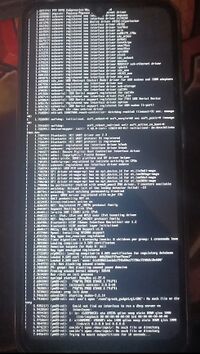Xiaomi Redmi 9A (xiaomi-dandelion)
| This device has been tested with postmarketOS, but its device package has not yet been added to the postmarketOS repositories. This means that it cannot be selected in pmbootstrap. Status: Welcome to postmarketOS./Kernel 6.10.0-rc3-next-20240613-mt6765 on an aarch64 (/dev/tty1) |
 Xiaomi Redmi 9A (xiaomi-dandelion) | |
| Manufacturer | Xiaomi |
|---|---|
| Name | Redmi 9A |
| Codename | xiaomi-dandelion |
| Model | M2006C3LG/M2006C3LC/M2006C3LI |
| Released | 2020 |
| Type | handset |
| Hardware | |
| Chipset | Mediatek Helio G25 (MT6762G) |
| CPU |
Octa-core (4x2.0 GHz Cortex-A53 4x1.5 GHz Cortex-A53) |
| GPU | PowerVR GE8320 |
| Display | 720 x 1600 IPS LCD |
| Storage | 32GB/64GB/128GB |
| Memory | 2GB/3GB/4GB |
| Architecture | aarch64 |
| Software | |
Original software The software and version the device was shipped with. |
MIUI 12 Android 10 |
Extended version The most recent supported version from the manufacturer. |
MIUI 12 |
| FOSS bootloader |
|
| postmarketOS | |
Mainline Instead of a Linux kernel fork, it is possible to run (Close to) Mainline. |
no |
pmOS kernel The kernel version that runs on the device's port. |
6.10.0-rc3-next-20240613-mt6765 |
Unixbench score Unixbench Whetstone/Dhrystone score. See Unixbench. |
0.0 |
Flashing Whether it is possible to flash the device with pmbootstrap flasher. |
Works
|
|---|---|
USB Networking After connecting the device with USB to your PC, you can connect to it via telnet (initramfs) or SSH (booted system). |
Broken
|
Internal storage eMMC, SD cards, UFS... |
Broken
|
SD card Also includes other external storage cards. |
Works
|
Battery Whether charging and battery level reporting work. |
Untested
|
Screen Whether the display works; ideally with sleep mode and brightness control. |
Partial
|
Touchscreen |
Untested
|
| Multimedia | |
3D Acceleration |
Untested
|
Audio Audio playback, microphone, headset and buttons. |
Untested
|
Camera |
Untested
|
Camera Flash |
Untested
|
| Connectivity | |
WiFi |
Untested
|
Bluetooth |
Untested
|
Ethernet |
Untested
|
GPS |
Untested
|
| Modem | |
Calls |
Untested
|
SMS |
Untested
|
Mobile data |
Untested
|
| Miscellaneous | |
FDE Full disk encryption and unlocking with unl0kr. |
Untested
|
USB OTG USB On-The-Go or USB-C Role switching. |
Untested
|
HDMI/DP Video and audio output with HDMI or DisplayPort. |
Untested
|
| Sensors | |
Accelerometer Handles automatic screen rotation in many interfaces. |
Untested
|
Ambient Light Measures the light level; used for automatic screen dimming in many interfaces. |
Untested
|
Proximity |
Untested
|
Haptics |
Untested
|
Power Sensor Sensor to monitor current, voltage and power. Not fuel gauge! |
Untested
|
Contributors
- evilMyQueen (wiki page and a mainliner of the device)
Users owning this device
- Azuk1 (Notes: testing mainline)
- EvilSoCute (Notes: Mainline dropped for now)
- Kaloyan Donev (Notes: 9AT, Dead motherboard)
- Paradoxvirus (Notes: testing port)
- Rebel1725 (Notes: successfully built pmos but bootloop)
The current state of the device
Boots with uniLoader and postmarketOS edge.
Mainline kernel boots at cpu0 with a framebuffer display, brings up secondary cpus and mounts rootfs at sdcard. Currently EMMC dead, touchscreen dead (no drivers), telnet dead, ssh dead, making it impossible for now to actually use the debug shell and/or the console. YAY
Too much versions of a single phone
There is THREE (as far as i know) versions of dandelion: M2006C3LG, M2006C3LC and M2006C3LI. (maybe more, im not sure) The phones can have a different firmware (R vendor and Q vendor) I've already saw the difference. In Q and R framebuffer has A DIFFERENT address. R vendor has more reserved-memory nodes than the Q The phone can have DRAM from 2GB to 3GB and up to 4GB And it can have 32GB storage, 64GB and the 128GB
[Then, on which version you (evilMyQueen), booting linux?]
Xiaomi Redmi 9A (xiaomi-dandelion) M2006C3LG R vendor 2/32GB with the adomerle linux kernel fork (needs rebase tbh)
"Hello" tested it on M2006C3LG and everything works the same (R VENDOR) [Which phone do i have?]
In the settings, you can find how much RAM and storage you have R vendor (most AOSP is here) is (i think) is MIUI 12.5, while Q vendor is MIUI 12 To check the exact model, just open settings, open "about phone" and scroll until you see "Device name"
See also
linux kernel mainline forked from adomerle/ uniLoader bootshim